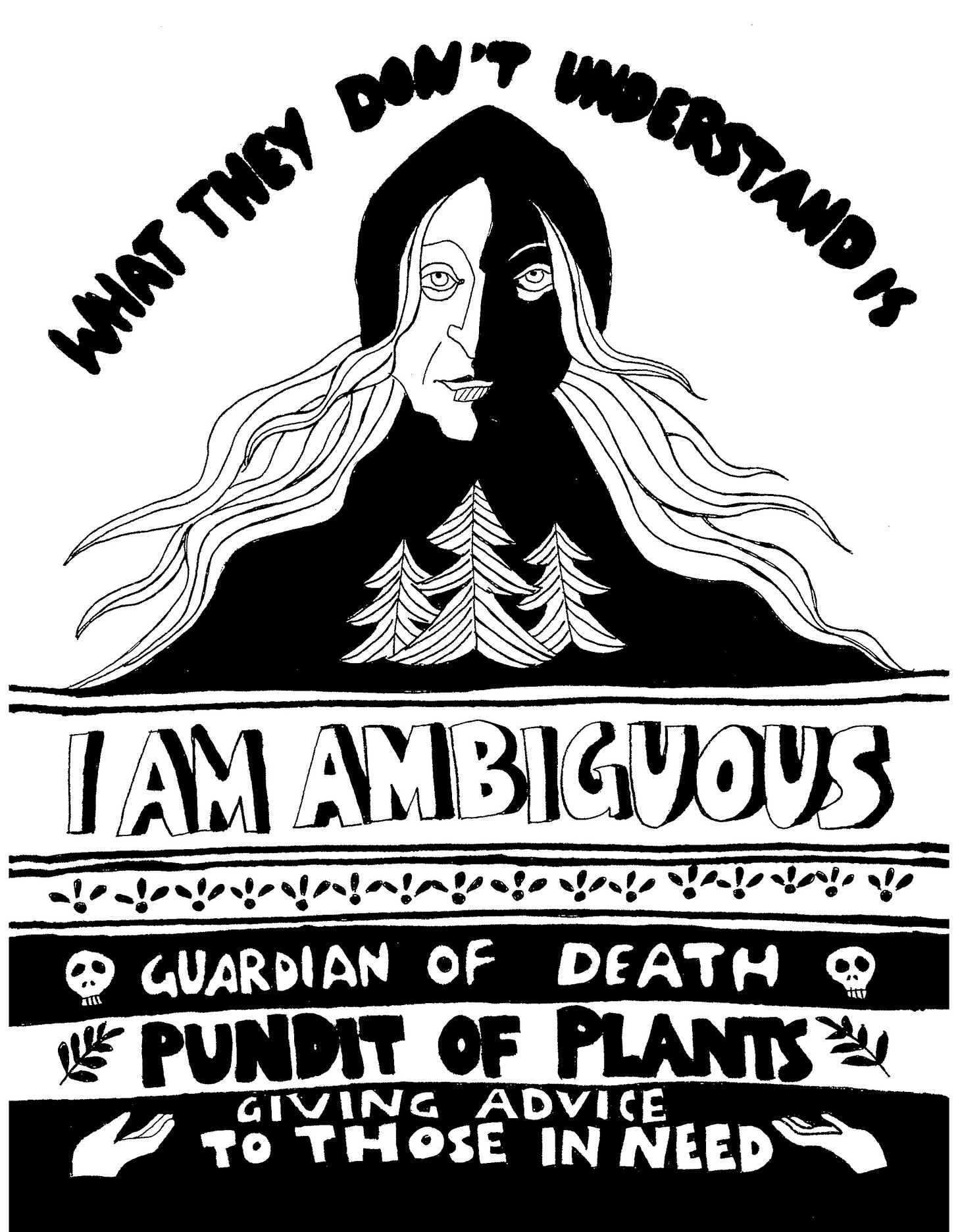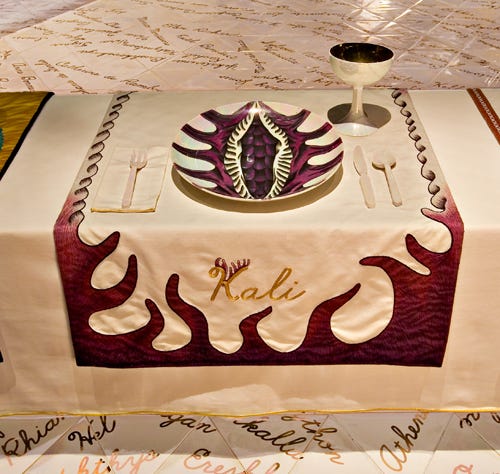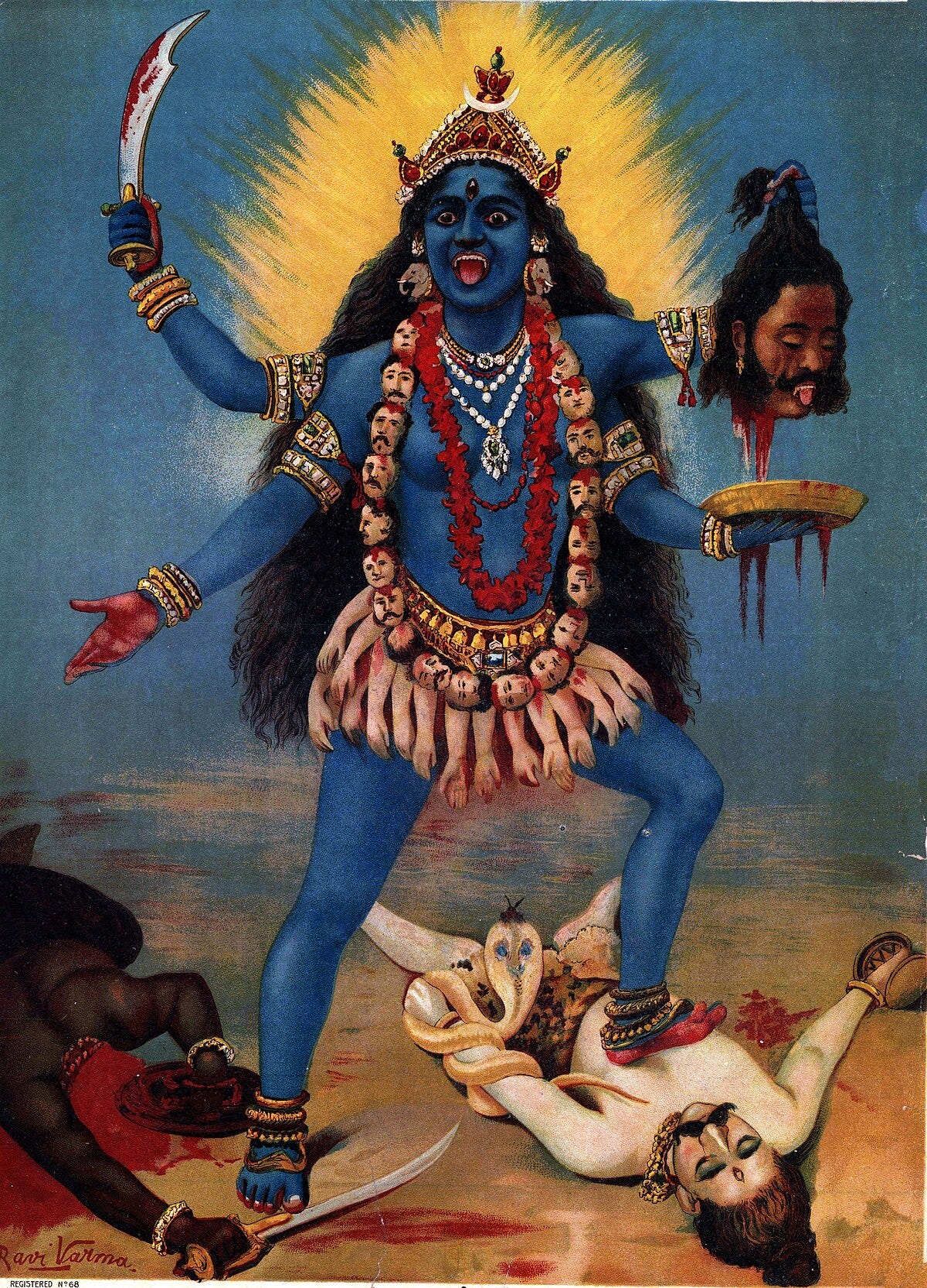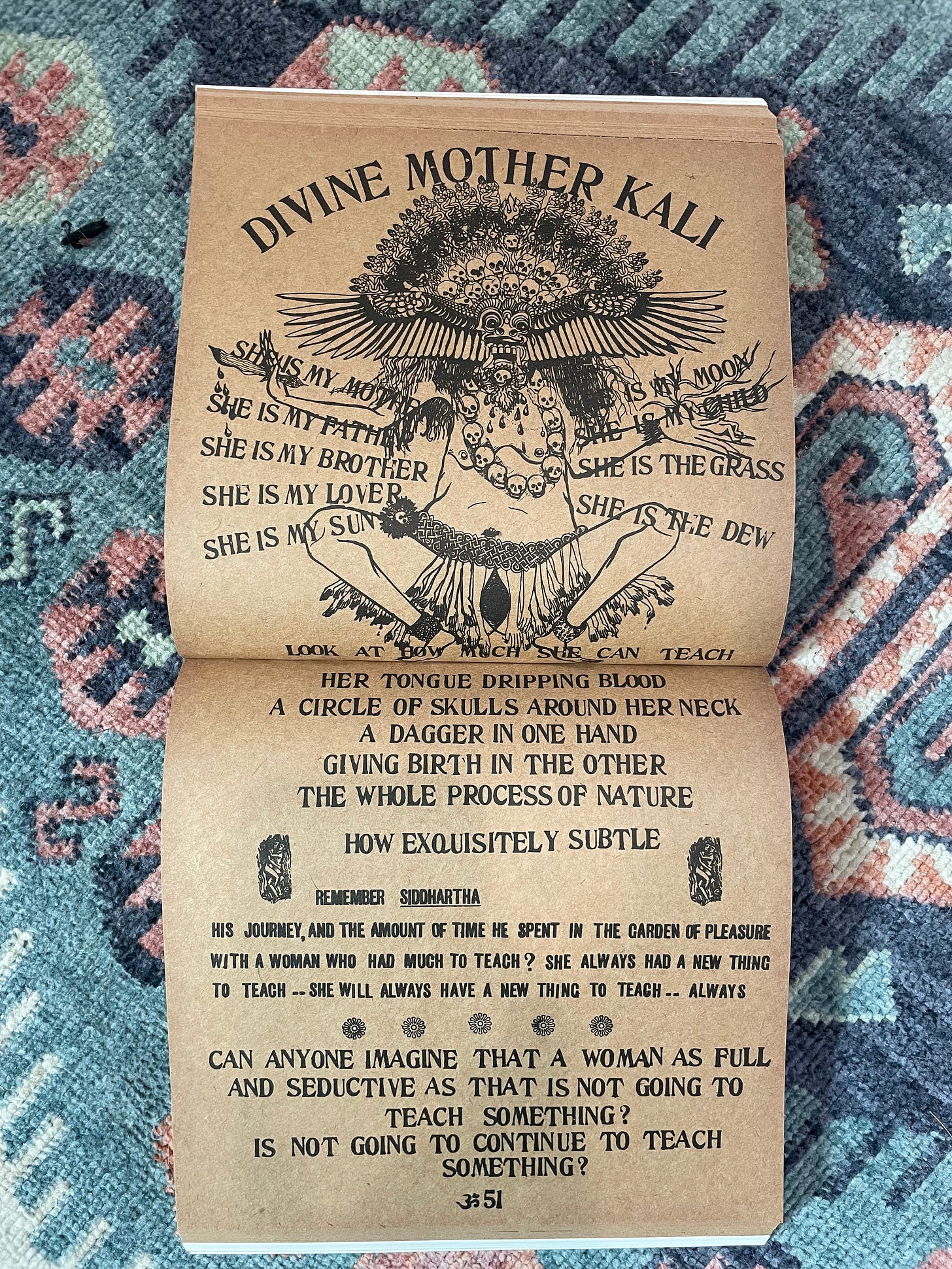The Mother's Most Misunderstood Faces
on Baba Yaga, Kali, and serving the non-rational and the darkness
What’s up, swimmers?! We have our first eclipse of the year on Monday, March 25th. I’m sending your nervous system so much gentle love as we allow our ships to be divinely rerouted.
I’m going to be sharing some of my week with you today, and the ways in which the winds of winter aren’t going out without a fight. And while yes, I am safe, supported, and loved, if you have been thinking about supporting my work here by becoming a paid pal, or getting a reading with me on Moonlight for the new year, eclipse season, or a question on your heart and mind—it would mean so much to me right now. Thank you for being here, thank you for your support.
A couple of weeks ago, I wrote,
It’s okay if [The Great Work] feels far away or intangible to you. That is the work of this month. To rexamine, redirect energy, rewrite narratives, and resource ourselves for the world that is coming—the one we will nurture together, out of the ruins of the one that is no longer serving us. That is what lies in the lap of the Divine Mother.
I also wrote that she teaches us how to die as much as she teaches us how to live.
However, we kept it light. We greeted her with sweetness and beauty. We united with her; we worshipped her; we embodied her.
This week, we’re going to get to know some of her scarier faces; her most misunderstood faces—Baba Yaga and Kali.
“Last Week on SITS—”
Here’s what you’ve missed this month on The Year of Yearning:
First,
I wrote about the numbers of March 2024: three, eight, and eleven/two, and how important—and difficult—it is to stay soft in the seat of severity.
I introduced our Mentors of the Month: The Empress with Keep Up the Good Work, and the Seven of Swords with Reset. These cards have asked that for March, we commune with the Divine Mother in ways that allow us to shed “The Myth of Not-Enoughness.”
I shared about my shroom-induced painting sesh at the beginning of my last three-ruled year, which produced a pregnant figure—The Mother as bearer, as birther, as channel.
We acknowledged that while her children, her body, her planet are sick with grief, violence, and disease, it is not too late to (re)commit to the Great Work. We also noticed our resistance to this work, and the fear that it might—we might—not be enough.
Ram Dass helped us to unite and merge with the Mother, and Hanna Williams reminded us that we may experience the Divine as cyclical experiences of concealment and revealment. So I offered ritual actions that we can take to know her.
Then,
I wrote about another experience I had with mushrooms, during the most recent Pisces Cazimi, and how it didn’t exactly go according to plan.
I also shared about some things that I’ve been loving on lately, including an excerpt from
’s essay Rebranding God, a potent note from a pal, and another piece of Seven of Swords wisdom from Lindsay Mack.
Baba Yaga, the Old Wild Mother
On Monday, in our household, eclipse season started early. One minute, something was there. The next, it was not.
I’m not able to share specifics, but I trust that you’ll recognize the experience through it’s bodily symptoms: gut-churning nausea, a thickening of the throat, a heart beating out of rhythm. Tears pouring from the depths of the Piscean sea.
Then came the anger. Hot, and roiling. Thick with a holy righteousness.
I decided to clean my kitchen.
The dishwasher unloaded and reloaded, the counter and stove tops wiped clean, I grabbed for the electric mop. This bitch was getting a full service, top to bottom tune-up until she shined.
She was gorgeous. I felt a smug satisfaction and an ache in my wrists.
Somewhere towards the end of my mop job, my mind wandered the old Slavic story of Vasalisa and Baby Yaga, shared by Dr. Clarissa Pinkola Estés in her book Women Who Run With Wolves: Myths and Stories of the Wild Woman Archetype. If you’ve read The Witch’s Book of Numbers, you might remember it from the chapter on the number five.
While I deeply encourage reading both of the texts listed above, what you need to know for today is that the specifics of the story of Vasalisa are standard issue for most stories about Baba Yaga, the witch of the woods.
As artist Christina Claes writes in her author’s note that follows her visual poem Baba Yaga's Ecofeminist Manifesto:
“Baba Yaga, often interpreted as a personification of nature and a mediator between life and death, is an ambiguous and most complex individual: In quite an unpredictable manner, she varies between acting as a benefactor and a villain, either helping or hindering those who encounter her deep down in the woods. Travelers crossing her way are made to do household chores and other work for her, and those who fail to complete her tasks meet the fate of being cooked and eaten by her. Her hut is said to be surrounded by human bones, and she terrifies children and adults equally.”1

In Women Who Run With Wolves, Estés likens Baba Yaga to another archetypal figure: the Old Wild Mother. She then goes on to discuss the story of Vasalisa through the lens of nine tasks the psyche must complete to learn her ways. The fifth task, called ‘Serving the Non-Rational,’ takes place at the point of the story where Vasalisa is tasked with doing Baba Yaga’s household chores.
Estés’s posits there is great significance in cleansing, tending to, and nourishing the body, the home, and the psyche. She says it’s what keeps us centered and grounded during times of turmoil. Mundane, yet magical tasks of tending to the hearth of the home and heart teach us “to cringe away from the big, the mighty, the cyclical, the unforeseen, the unexpected, the cast and grand scale which is the size of Nature, the odd, the strange, and the unusual… [Like Baba Yaga, we must be] both Rhyme and Reason.”2

Baba Yaga is a face of the Mother, but a misunderstood one. While her stories are brutal, her violence more closely resembles the ruthlessness of Nature itself, which both creates and destroys. It is not personal then, but natural.
She is the Russian proverb that says "the oven is our mother."
Baba Yaga offers us protection, but only once we have finished her chores. She offers us the oppotunity to be further forged through fire, if we can stand the heat. She is the Mother that scolds us, punishes us, and loses her temper. But her love is no less revolutionary or transformative. In fact, it is the love that weaves its way through the cycles of life, death and rebirth. She is the sacred compost, and a deep ally and teacher when things go awry.
Here is Christina Claes’s visual poem, Baba Yaga's Ecofeminist Manifesto, in full:
They want to figure out if I am good or bad
They say I eat childrenWhat they don’t understand is
I AM AMBIGUOUS
GUARDIAN OF DEATH
PUNDIT OF PLANTS
GIVING ADVICE TO THOSE IN NEEDI’m NOT your mother here to nourish you
NOR will you ever succeed in mastering meYES I CAN SUSTAIN AND DESTROY YOU
BUT NOT BECAUSE I’M GOOD OR BADBUT BECAUSE ALL EXISTENCE IS INTERWOVEN WITH EACH OTHER, A FLOURISHING CIRCLE OF LIFE AND DEATH.
AND WHAT DIES BECOMES SOIL FOR NEW SEEDS.
Offerings for Baba Yaga: Beeswax candles, bones, tobacco, black tea, bread and salt, vodka, water, greenery, soil and stones
Kali, She Who is Black
The morning after I cleaned the kitchen was the Spring Equinox. The Sun shifted into Aries at eight in the morning, and I was there to greet it. I sat outside in my backyard, on the ground, legs crossed, hands open open open. A fixed candle charged in front of me. A playlist of fiery women played in my ears. I sent all of my energy towards the candle, towards the new year. I was so grateful!
I didn’t tend to the candle as much as I would’ve liked to after the first day. The waves were heavy and I spent most of my time working and writing and walking and weeping. But I checked on it often, saying quick hellos. Smelling its earthy fresh scent. The candle didn’t mind my absences; the candle still burned. Bright and blazing, hissing as its wax melted down and disappeared into vapor. Flickering against the ceiling as I failed to sleep in the next room over.
My wife had never seen Season 1 of Love is Blind, so we watched the whole thing in two days. Jessica’s baby voice still creeped me the fuck out, but it was nice to know that some things never change. It felt good to yell at the television! To scream at these people who got engaged site unseen after a few days of talking through a lava lamp-looking wall.
In the midst of my silliness and my wrath, I heard a name—Kali.
Kali is a Hindu deity and the primary Goddess of Yoga. Her plate at Judy Chicago’s The Dinner Party, which is a permanent installation at the Brooklyn Museum and boasts thirty-nine place settings for famous women at a triangular table, is blood-red and vaginal. A “gaping maw,” says Chicago.3
(It’s worth noting that thirty-nine reduces to three, the number of March and the Empress, with the triangle representing three’s sacred shape!)
“[Kali] is a complicated symbol, simultaneously feared and adored. As she is associated with the opposing forces of destruction and death, as well as creation and salvation, she has been characterized as both vicious and nurturing. She serves as a reminder of death’s inevitability, which encourages acceptance and dispels fear.”4
Her name is said to translate to “she who is black.”5

Kali has many names. In some circles, she is known Ma Kali, the Mother Goddess. Her energy is that of a Mama Bear, provoked and protecting her young. Unafraid to take life. Righteous in her anger and arousal. The world is harsh, but she is strong-willed, brandishing weaponry in her many arms, her mouth smeared with blood.
But her purpose is as clear as her love for us. Like Baba Yaga, she is here to teach us through life’s many trials and tribulations. She sticks her tongue out at that which doubts her power and invites us to do the same. She equips us for battle, but also invites us to meet ourselves on a mental and psychic battlefield. Her energy is our energy; her wrath is our wrath. Her home is our home, and she will continue to call us back in.
“Ma Kali’s energy is like a simulated death experience. She helps us withdraw our attention from the outer mind, emotions and senses into the inner heart. In this regard, Kali is the prime Goddess of Jnana or Self-knowledge. She takes us back to the Self in the heart, unifying all our experience within it. Kali is Nirvana Shakti, the power that takes us to dissolution or Nirvana. She is the magnetic pull of Nirvana within us.”6
This morning, I woke with a start. I didn’t know what time it was, but it was still dark outside. Dark inside, too.
I smelled smoke.
Rushing to my office, where my Spring Equinox fixed candle was burning, I noticed a change in the scent. I knew the final moments of its magic were fast approaching. Sure enough, the flame had softened around the remnants of the wick, egg-shaped and enveloping it fully. I stood in front of it, my hands clasped, my eyes thick with sleep, and I prayed. I said thanks. I remembered my intentions and sent my energy to the candle.
The flame extinguished, but the embers still burned. The remnants. The ruins. Then that light went out too, plunging me into pitch darkness. The realm of Kali. In fact, some say to worship her through the night, meditating as the dark gives way to the dawn.
I felt a comfort. Gratitude. The inner flame of my magic burning in my belly, so strong it had woken me up. The spell was cast, but far from over. In fact, this is just the beginning. Everything is unknown, yet everything is possible.
So be it, so it is.
In Be Here Now, after the pages we read last week, Ram Dass speaks of Kali:
DIVINE MOTHER KALI
SHE IS MY MOTHER
SHE IS MY FATHER
SHE IS MY BROTHER
SHE IS MY LOVER
SHE IS MY SUNSHE IS MY MOON
SHE IS MY CHILD
SHE IS THE GRASS
SHE IS THE DEWLOOK AT HOW MUCH SHE CAN TEACH
HER TONGUE DRIPPING BLOOD
A CIRCLE OF SKULLS AROUND HER NECK
A DAGGER IN ONE HAND
GIVING BIRTH IN THE OTHER
THE WHOLE PROCESS OF NATUREHOW EXQUISITELY SUBTLE
Remember Siddhartha
His journey, and the amount of time he spent in the Garden of Pleasure
With a woman how had much to teach? She always had a new thing
To teach — She will always have a new thing to teach — AlwaysCAN ANYONE IMAGINE THAT A WOMAN AS FULL
AND SEDUCTIVE AS THAT IS NOT GOING TO
TEACH SOMETHING?
IS NOT GOING TO CONTINUE TO TEACH
SOMETHING?
Offerings to Kali: Red hibiscus flowers, sweets, rice, lentils, Nag Champa incense, black candles, liqour, honey, fresh fruits
A reminder of the energy still upon us:
In a slight shift from the previous months, we’re approaching March from a place of process, not product. We’re creating, yes, but for the love and act of it.
Become less concerned with outcomes. Give up attachments to results. Commit yourself to your practices. Find pleasure in the blood, sweat and tears. Sit in awe of your Divine Spark, which lives in everyone. Come to care for all children of the Divine Mother. Take action from this place. Everything for the glory of the One.
Until next time, just keep swimming!
xx, Rebecca
Beyond the Mother Metaphor: Baba Yaga's Ecofeminist Manifesto by Christina Claes.
Women Who Run with the Wolves: Myths and Stories of the Wild Woman Archetype by Clarissa Pinkola Estés, Ph.D.
Embroidering Our Heritage: The Dinner Party Needlework by Judy Chicago.
The Goddess Kali and the Spiritual Heart by Vamadeva Shastri.







